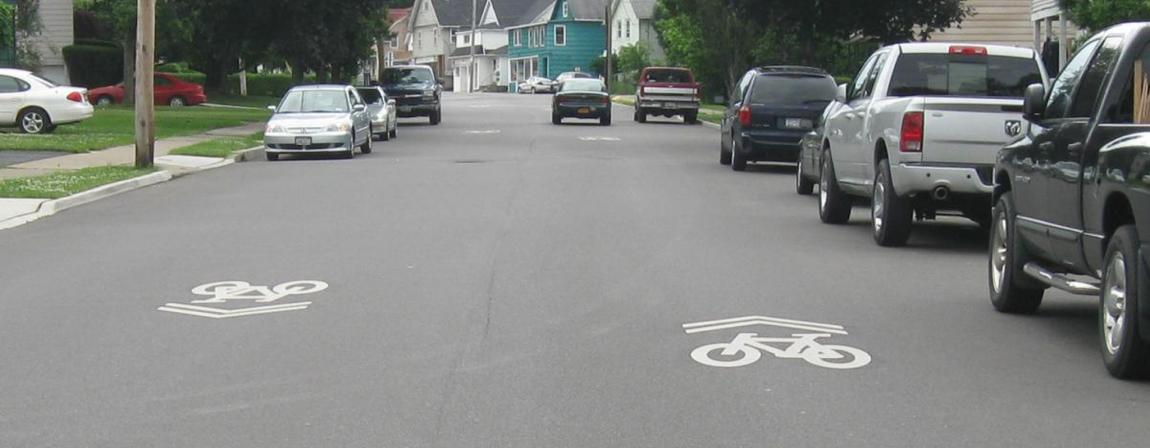You may have noticed the above markings were installed in the City of Binghamton on Riverside Drive, and in other places around the area. You may be wondering, "What is that?!?"
That is a sharrow. Sharrows are pavement markings that improve cycling safety on streets that are too narrow for traditional bike lanes. These markings indicate to drivers that the road is a preferred bicycle route, and that they should be prepared to share the road with cyclists. The placement of the sharrow shows cyclists where they can ride to avoid traveling in the door zone of parked cars. The following video from the Iowa Bicycle Coalition provides a brief overview of sharrows.
FAQ on Sharrows
FAQ for Shared Roadway Markings "Sharrows"
Q. I've seen these new markings of a bike with two chevrons/arrows above it on the streets. What do they mean?
A. These are "Shared Roadway Markings" which are intended to show where cyclists can ride on the street without being hit by a suddenly opened car door. Although it is the motorist's responsibility to check before opening their door, riding too close to parked cars (in the "door zone") is still a common mistake that can lead to serious injury. These markings will also be used in situations where it may not be obvious where cyclists should be riding, such as at intersections with multiple turn lanes.
Q. But on some streets, cyclists riding over this marking will take the entire lane. Aren't they supposed to move to the right?
A. Not always. Cyclists are to stay to the right except to pass other cyclists or vehicles, to prepare to make a left turn, or when necessary to avoid conditions (ncluding fixed or moving objects, surface hazards, or substandard width lanes too narrow for a bicycle and vehicle to travel side by side) that make it unsafe to continue along the right. Moving to the left in the lane to avoid car doors, for instance, even if it means taking the entire lane, is permitted.
Q. Can't cyclists just look into parked cars as they ride and see if someone is about to open the door?
A. This can be very difficult to do. Cyclists, along with all road users, need to constantly scan the entire roadway for safety. Checking every car for a driver is difficult to do without compromising attention paid to the road. Also, it is often impossible to see drivers due to large parked vehicles blocking the view of other parked vehicles, tinted windows, headrests, etc. Car drivers should check their sideview mirror or look back prior to opening their door.
Q. If I see these markings in a lane, is the lane only for bikes?
A. No. This marking is used for shared lanes; lanes that are used by bicyclists and motorists. Shared lanes are different than bike lanes which are set aside for bicyclists and are marked by a solid white line and a different symbol.
Q. So, if I don't see these markings, then it's not a shared lane and bicyclists aren't supposed to be there?
A. No, cyclists can ride on any street except for limited access freeways and those with signs explicitly prohibiting cyclists. Cyclists are allowed on every street regardless of whether there is a marking or sign for them, unless stated otherwise.
Q. I've never seen these markings before. Why are they being used now?
A. In 2009, the Federal Highway Administration approved the use of Shared Roadway Markings (Sharrows) in their Manual on Uniform Traffic Control Devices (MUTCD). Several cities around the country are using sharrows on streets that are popular with cyclists but may be too narrow for conventional bicycle lanes.
The overall goals are: to improve the position of bicyclists and motorists on roads without bike lanes, reduce aggressive motorist behavior, encourage correct bicycling behavior and increase the comfort of (and therefore the number of) bicyclists on shared roads. Sharrows also cut down on the number of sidewalk cyclists and wrong-way cyclists.
More details about the sharrows/shared lane markings and guidance for their use.

